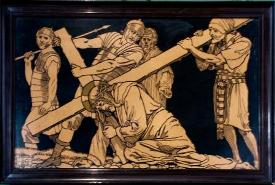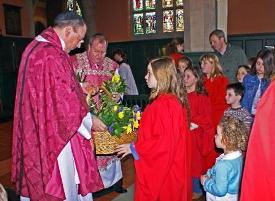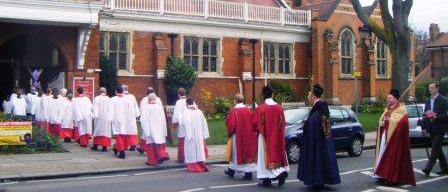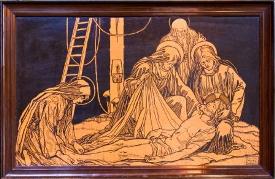
Lent at St Michael & All Angels 2016
St Michael’s in Lent
Cathie James, Master of Ceremonies, offers this brief liturgical guide
When and what is Lent?
Lent (from the Old English lencten meaning ‘spring’) is the Christian church’s season before Easter. It starts on Ash Wednesday (February 10th 2016) and ends on Maundy (Holy) Thursday (March 24th 2016), the start of the great Easter Triduum. This picture (right) is one of the images from the Stations of the Cross (see below).
Lent actually lasts 44 days but traditionally Sundays were excluded from the Lenten restrictions and hence we arrive at the 40 days usually associated with Lent, which is also the duration of Christ’s fasting and prayer in the wilderness. In the early church the forty days was a time of special training for catechumens (converts under instruction) preparing for baptism at Easter.
The Lenten period for Christians is specifically directed to self examination, reflection, and penitence - a sort of spiritual ‘spring cleaning’ – hence the activities associated with this season; fasting or self denial, charitable giving, and growth through prayer, and bible study. St Michael’s offers opportunities for all of these through its programme of weekly study groups, Sunday morning themed sermons, recommended Lent reading, Lent lunches, and a number of other events.
The simplicity and penitential nature of Lent is reflected in the liturgy we practice at St Michael’s during this time and what follows is a brief guide to the Lenten services and their symbolism.
The church and its services in Lent – what is different?
Ash Wednesday
Ash Wednesday is the first day of Lent. The ashes from which the day gets its name come from the burning of palm crosses that were blessed the previous year on Palm Sunday (see below). The ash is mixed with holy water and imposed on the forehead of each recipient by the priest, making the sign of the cross with the words ‘remember you are dust and to dust you shall return’. The ashes serve a dual purpose, they remind us of our humanity and mortality, and they are the Biblical symbol of repentance and humility. It is a deeply penitential rite with which to mark the start of the Lenten season
The Mass in Lent
To reflect the penitential simplicity of Lent, there are changes at St Michael’s both during services and in other ways. During Sunday Mass you will see only a plain linen cloth on the nave altar and no fall on the lectern. The ornamental candlesticks usually on the nave altar are replaced with plainer versions.
There are no flowers in church throughout the whole of Lent (the only exception being Mothering Sunday (see below)) and generally speaking no baptisms or weddings take place during this time.
Again reflecting the penitential nature of the Lenten season, the liturgical colour is purple and so throughout Lent you will see a purple frontal on the high altar and the priests at the Mass wearing purple stoles and chasubles.
The priests’ white albs under their chasubles will be plain, as will the white cottas worn by the altar servers.
The use of the organ is restrained and no voluntaries are played when the Mass is ended.
The liturgy of the Mass itself changes in Lent reflecting the stark simplicity that is its theme. The joyful ‘Gloria’ and ‘Alleluia’ are omitted and the penitential Lent Prose is sung before the Gospel.
The words in which we declare the ‘mystery of faith’ during the Eucharistic prayer change to:
'Lord by your Cross and Resurrection you have set us free: You are the saviour of the world.'
What about Mothering Sunday?
There is a lightening of the mood on the fourth Sunday in Lent, also known as Laudate or Laetare (praise, rejoice) Sunday but more familiarly celebrated as Mothering Sunday (March 15th 2015). This is only one of two occasions in the year (the other being Gaudete Sunday; the third Sunday in Advent) when the St Michael’s clergy wear (very beautiful) rose pink vestments. The St Michael’s Family Service, which normally takes place on the first Sunday each month, moves to Mothering Sunday; there are flowers at the statue of Our Lady and the children give bunches of spring blooms to their mothers and other members of the congregation. The original intention of this day was not, however, to honour our mothers but was traditionally a time when one returned to one’s ‘mother’ church.
What happens on Passion and Palm Sundays?
From the fifth Sunday in Lent – Passion Sunday (March 13th 2016) – the mood becomes more sombre and all statues and crucifixes in the church are covered with purple muslin.

What are ‘The Stations of the Cross’?
 At St Michael’s every Friday evening (6.30pm) in Lent there is a meditation on the ‘Stations of the Cross’.
At St Michael’s every Friday evening (6.30pm) in Lent there is a meditation on the ‘Stations of the Cross’.
The Stations of the Cross mark fourteen events in the Passion and death of Christ which are shown in pictures hung sequentially around the walls of the church (see picture above). The fourteen stations are:
- Jesus is condemned to death
- Jesus takes up his cross
- Jesus falls for the first time
- Jesus meets His Mother;
- Simon of Cyrene helps Jesus carry his cross ;
- Veronica wipes the face of Jesus
- Jesus falls for the second time
- Jesus meets the women of Jerusalem;
- Jesus falls for the third time
- Jesus is stripped of His garments
- Jesus is nailed to the cross
- Jesus dies on the cross
- Jesus is taken down from the cross
- Jesus is laid in the tomb
Following the way of the Cross is a pilgrimage in miniature of Christ’s final journey– at each station a devotion is made with prayers, a meditation and a hymn, and we process from one station to the next until the fourteenth is reached, where Jesus is laid in the tomb.
At St Michael’s, unlike some churches, the pictorial stations are not displayed all year round – just the Roman numerals 1 – X1V, set into wooden crosses, can be seen on the green panelling. It is only in Lent that the pictures themselves are put in place (see photograph).
Making the Stations of the Cross is a richly symbolic enactment of Christ’s injunction to take up our cross and follow him – the liturgy is very beautiful and is perhaps at its most intense when the Stations are followed immediately prior to The Liturgy of the Lord’s Passion on Good Friday.
Throughout Lent at St Michael’s the symbolism of its rituals constantly reminds us that it is a season for self examination, humility, charity and penitence. A deeper understanding of the Lenten liturgy enhances our spiritual insight and awareness. It helps us prepare ourselves for Easter and assists us to observe a ‘good and holy Lent’.